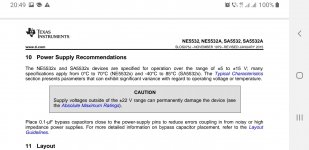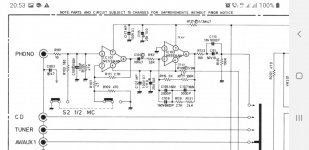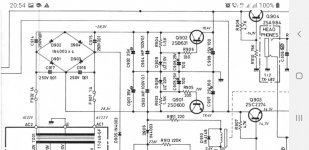With higher gains C2 might become useless too or at least lower in value thus have better slew rate with 10....47pF.Check MC op amp datasheet for its recommended compensations with gain.
If you are going the regulator route... no heatsinks needed. The current is far to low to cause them to run hot. Series resistors need to lose around 8 volts or so. Try 330 or 390 ohm @ 0.25 watt or 0.5 watt. Make sure to add decoupling caps close the regs input and output. I would use something 10uF 63V caps soldered direct to the pins if this is being added 'dead bug style'.Ok, I`m back from the store... they had 7818 and 7918....
It all depends how you want to wire it. You could replace those 6k8's with the 330 or 390 ohm and fit the regs directly after. Cut the print and tag them on the board. I would need one in front of me to see how best to do it.
Was that one of mine 😀I have the preamp that @Mooly designed for me in 2017 ... wow time flies so fast... I need the gain because Zeck amplifier uses +4dBu line level... I attached the schematic. Its a single rail design with 4558 / TL072 / NE5532 IC....
So it was, I still have the file. You can easily make it dual rail if needed.
Attachments
Actually I was surprised to find the opposite.If you are going the regulator route... no heatsinks needed. The current is far to low to cause them to run hot.
The highest voltage supply design I saw for ne5534 ( which is only half the ne5532 )and has also half the idle current running through it so two ne5534 would dissipate twice as one ne5532 , was in Rotel RC850 +-19.4 V and the people aren't too happy with its sound although it's quite sophisticated and uses 2 stages with one inverted.
At +-18v supply with a minimum idle current of 8mA for ne5532 , it dissipates 288mW only by doing nothing...and TI says explicitely that the idle current can be twice of that.The dip case can only do away with about 5...600mWatts, so the +-11...15v supply usually found in ne5532 designs has a reason, unless its the SA smd version which can dissipate almost twice the power of ne5534, but that it's rarely found .I have some...never used them yet...
2 x NE5534 would make the ballgame easier at 4min ...8max mA compared to 8...16mA for ne5532.
I don't advertise the use of heatsinks on opamps for fun cause it's no real fun in it...The military versions use ceramic case for a reason.
It amazed me for years why people reported so much different result for ne5534 applications, until I noticed that the more modern smd version actually exhibits better results not because of the superior parameters, but because the case runs colder being usually in close contact(even glued) to the pcb, often having a groundplane attached and the case is also thinner transmiting the heat easier to the pcb .
When reworking older designs you don't modify the existing pcb...so you can only do away with the heat by using heatsinks...
Attachments
Last edited:
If you are going the regulator route... no heatsinks needed.
Actually I was surprised to find the opposite.
Let's put some numbers in...
For a 36 volt supply and the opamp pulls 16ma worst case (NE5532). Series resistor to regulator is 330 ohm. Regulator Iq is say 2 milliamps. Regulator voltage is 18 volt
We have 18 ma in the 330 ohm. Approx 6 volts is dropped across the resistor. Dissipation in the resistor is 0.11 watt. The regulator has a 12 volt input/output differential @ 18 milliamp current flow. Dissipation in the reg is 0.22 watt
I was talking about the dissipation in the ne5532 op amps with a differential voltage of 36V x an idle current of 8mA (minimum current), not the regulators or series resistors.
I just posted my take on my next embodiment of inverted part of the P10 preamp with pictures here :
https://www.diyaudio.com/community/...plete-schematic-with-bom.391604/#post-7168502
You're free to express your
moment . You should have intellectual rights in your name over it 🙂 !
I remember 17 years ago when I had to fix a Behringer crossover in a dicotheque where the guy told me that after 10 minutes of work the sound became muddy...and after a quick look I just told the guy to buy another crossover of a better make cause the njm4558 smd chips were simply hot at +-15V supply.Designers often forget that these chips aren't too good at dissipating heat and they need some external help to stay cool.
Heat is the number one ennemy of low noise electronics...
I just posted my take on my next embodiment of inverted part of the P10 preamp with pictures here :
https://www.diyaudio.com/community/...plete-schematic-with-bom.391604/#post-7168502
You're free to express your
I remember 17 years ago when I had to fix a Behringer crossover in a dicotheque where the guy told me that after 10 minutes of work the sound became muddy...and after a quick look I just told the guy to buy another crossover of a better make cause the njm4558 smd chips were simply hot at +-15V supply.Designers often forget that these chips aren't too good at dissipating heat and they need some external help to stay cool.
Heat is the number one ennemy of low noise electronics...
Last edited:
Heat is the number one ennemy of low noise electronics...
It's all relative though. Opamps of the 5532 type have managed without issue (and they are designed to manage without issue).
I remember 17 years ago when I had to fix a Behringer crossover in a dicotheque where the guy told me that after 10 minutes of work the sound became muddy...and after a quick look I just told the guy to buy another crossover of a better make cause the njm4558 smd chips were simply hot at +-15V supply
A quick look inside isn't a proper diagnostic on a problem. If the fault was real it could have any number of causes and ultimately measurable.
All this is miles away from what the op is asking though 🙂
I made sure they did by mechanically breaking three Signetics and one TI made in Portugal 🙂 well I wanted first to see to which pin is the substrate's radiator tied and I found it's not tied to any pin so I can't make an easy choice to which rail I should connect the heatsinks to get minimum distributed capacitance and that might be a problem .I'll try ground first. A friend of mine even suggested the use of Peltier elements...but that's kind of extreme although more effective.It's all relative though. Opamps of the 5532 type have managed without issue (and they are designed to manage without issue).
The substrate though has attached two metal forks like elements spreading the heat inside the resin and that probably helps a lot to keep it cool.
Anyway I tried as much as possible to look at all the aspects of a low noise phono preamp based on ne5532/34...
I could hardly understand what "muddy sound " ment to the guy...it was kind of the whole sound getting less clear , some "frrrr" noise starting to be heard after 10...15 minutes.the voltages were ok...I wouldn't have the time to check every smd component found in the cheapest behringer crossover 15 years ago... my romanian hourly rates were more expensive than the crossover worth if you can imagine that...A quick look inside isn't a proper diagnostic on a problem. If the fault was real it could have any number of causes and ultimately measurable.
Hy, thank you both for help I really appreciate it. But I slept over and figured it's time for me threat myself and finally step out of improvised old sound systems... I'm getting new amp.
I'm looking at Yamaha SA-501 and Marantz PM6007...
It's a hard choice, Yamaha looks better to my eyes because I like the look of 70s-80s amplifiers and this one in silver looks alike...
I'm looking at Yamaha SA-501 and Marantz PM6007...
It's a hard choice, Yamaha looks better to my eyes because I like the look of 70s-80s amplifiers and this one in silver looks alike...
Will do as I will use it somewhere for sure, later I will also replace my Pioneers in the living room so it will make nice system for the basement room or something 🙂 I have the spirit for work, its just that I want something better / new.Well that's one way to fix something 🙂
You can still keep playing around with this one though.
Well it sounds nice, punchy... it cant hide its power even at minimal volume. But I have 2 problems with it... first it have fans, they are on all the time and if you listen to music at low volumes, you hear them... Second is that me and my girlfriend dont have the same priorities... she looks at the amp like its a piece of furniture, my priority is sound... I always tell her to listen to music not to look at the music 🙂 I think that I will use it for subwoofer as it is powerfull.Well that Zeck amp of yours impressed me to be honest..
Last edited:
No, I'm a bit lucky to have women like that. She has a bit of interest on audio equipment and cars... But its the looks over the specs.I thought she'd look through the amp...does that amp look so awesome to catch women's attention? That's a first!
It couldn't get any better, I hope you're aware of it! Usually audio amplifiers look good in the shed for wives.
I'm aware 🙂 We started young and our first alone moment was actually cutting MDF for scooter under-seat speaker, because I had no jigsaw at the moment and she borrowed me her fathers. She also helps me from time to time and does good at ignoring 2/3 of our living room table being covered with my projects most of the time.It couldn't get any better, I hope you're aware of it! Usually audio amplifiers look good in the shed for wives.
I just came home with the amp. Went with Yamaha, it is a bit bright as some owners claimed, but it should break in and sound better then... I have no opinion on burn-in, phenomenom or real thing I don't know, time will tell...
Now I see what I was missing all this time... yes, Zeck sounds good, it really does, but it' a PA and it does great job for that is made. But this amp... I tought I knew how wide musical specter is... more likely I knew what is writen on paper... now I see that flat response 20hz to 20khz doesnt mean much by itself.
It sounds a bit dry on phono... but I guess thats the turntable.
And my old Pioneers... they went over my expectations.
I guess that I had just took the first step on road with no return...
Now I see what I was missing all this time... yes, Zeck sounds good, it really does, but it' a PA and it does great job for that is made. But this amp... I tought I knew how wide musical specter is... more likely I knew what is writen on paper... now I see that flat response 20hz to 20khz doesnt mean much by itself.
It sounds a bit dry on phono... but I guess thats the turntable.
And my old Pioneers... they went over my expectations.
I guess that I had just took the first step on road with no return...
- Home
- Amplifiers
- Chip Amps
- Hitachi HA-1, can I replace 4558?



